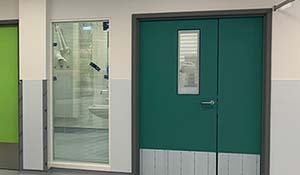In our second “in conversation with…,” Russell James talks to Neil Orpwood from HLM Architects to discuss standardisation within the healthcare sector.
Russell: Thanks for talking to us today about standardisation, as a very experienced Healthcare Architect, can you tell us what’s important to you when specifying a healthcare project considering standardisation?
Neil: One of the big things, that you at Specialist Door Solutions (SDS) understand is the need to get the design right from the outset, it’s about the ability to hand over a design that everybody knows is going to meet the requirements and can be manufactured in the factory and delivered to site smoothly and efficiently.
Russell: Neil, you and I have been working together on healthcare projects, can you tell me how does standardisation and the quality of the product affect what you do when you specify a project?
Neil: One of the key things for me with regards to individual products, is that suppliers like SDS understand because they’ve been developing a product that feeds into the market, so the design is right from the outset. It’s about an ability to have time to get things right at the front-end and an ability to deliver smoothly so that things fit neatly within the site, and they can handover and it does the job that it is supposed to do.
One of the key things there is an ability to design and get the job done right first time and don’t have to come back and repeat and waste money and lose efficiency.

Russell: That’s an interesting comment, I’ve spent an awful lot of time working with Trusts, Architects and Contractors directly. If we get the job done correctly at the beginning, we don’t need to go back in and start work in a ‘live’ environment. We don’t sacrifice the level of compliance either because if you get the right product in the first place, we can keep it at that level.
As a manufacturer, we’ve done a lot of work on standardisation, with a goal to bring a certified product that will allow us to deliver at speed, in budget, and to allow those ongoing savings and benefits such as easier onsite installation and maintenance going forwards. It’s interesting to hear your comments, and if we can produce a standard set, would that make your life easier?
Neil: It does, as architects one of the key elements is the aesthetics and it is important with standardisation that you don’t lose any of the joy that’s derived from the aesthetic experience within the healing environment. The ability to choose certain options, to provide that standard core design for the doors to provide the service that they need to, which can be wrapped, literally, in elements of aesthetics that suit job, to job.
Russell: Another thing that is key for us in conjunction with what you have just said, is that we can deliver a product that has the relevant design data, so the BIM models, EPD’s, any PM certification and the necessary fire certification. It is key for us that we can deliver those products as whole tested doorsets by third party auditors. That’s something I’m guessing is key to you as well.
Neil: It is, it feeds into the building information model and digitally smart hospitals. That ability to be able to develop a virtual design that runs through the whole design process, then to a contractor to build, and onto operation. And with that data set embedded from the outset, it does make life so much easier to be able to prove in terms of simulation modelling, to build the whole building through each of those component elements to achieve net zero carbon for example, in terms of final delivery.
Russell: I really enjoyed chatting to you today, thank you so much for your time.
To find out more about all of our products, please contact the team today.

